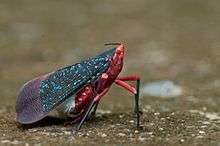Fulgoridae
| Fulgoridae | |
|---|---|
 | |
| Pyrops candelaria | |
| Scientific classification | |
| Kingdom: | Animalia |
| Phylum: | Arthropoda |
| Class: | Insecta |
| Order: | Hemiptera |
| Suborder: | Auchenorrhyncha |
| Infraorder: | Fulgoromorpha |
| Superfamily: | Fulgoroidea |
| Family: | Fulgoridae Latreille, 1807 |
| Subfamilies | |
|
| |
The family Fulgoridae is a large group of hemipteran insects, especially abundant and diverse in the tropics, containing over 125 genera worldwide. They are mostly of moderate to large size, many with a superficial resemblance to Lepidoptera due to their brilliant and varied coloration. Various genera and species (especially the genera Fulgora and Pyrops) are sometimes referred to as lanternflies or lanthorn flies, though they do not emit light.

The head of some species is produced into a hollow process (structure), resembling a snout, which is sometimes inflated and nearly as large as the body of the insect, sometimes elongated, narrow and apically upturned. It was believed, mainly on the authority of Maria Sibylla Merian, that this process, the so-called lantern, was luminous at night in the living insect. Carl Linnaeus adopted the statement without question and coined a number of specific names, such as laternaria, phosphorea and candelaria to illustrate the supposed fact, and thus propagated the myth.
Subfamiles and tribes
Metcalf in 1938,[1] as amended in 1947,[2] recognized five subfamilies (Amyclinae, Aphaeninae, Fulgorinae, Phenacinae, and Poiocerinae) and twelve tribes in the Fulgoridae. By 1963 Lallemand had divided the Fulgoridae into eight subfamilies (Amyclinae, Aphaeninae, Enchophorinae, Fulgorinae, Phenacinae, Poiocerinae, Xosopharinae and Zanninae) and eleven tribes.[3] This classification was generally accepted.[4][5]
However, in 2008 Julie Urban's molecular analysis in her dissertation[6] showed that a significant revamping of the Fulgoridae subfamilies and tribes would be necessary, as the morphological analysis by itself did not take into account the complexity of the Fulgoridae evolution. Her work was recapitulated in 2009 with Jason Cryan.[5] The Zanninae may not even be in the Fulgoridae.[5]
See also
References
- ↑ Metcalf, Zeno Payne (1938). "The Fulgorina of Barro Colorado and other parts of Panama". Bulletin of the Museum of Comparative Zoology. 82 (5): 277–423.
- ↑ Metcalf, Zeno Payne (1947). "Fulgoridae". General catalogue of the Hemiptera, Fascicle IV Fulgoroidea, Part 9. Northampton, Massachusetts: Smith College.
- ↑ Lallemand, Victor (1963). "Revision des Fulgoridae (Homoptera). Deuxième Partie. Faunes Asiatique et Australienne". Mémoires de l'Institut Royal des Sciences Naturelles de Belgique (2nd series). 75: 1–99. and the material there cited.
- ↑ Liang, Ai-Ping (1995). "Taxonomic changes in oriental Fulgoroidea (Hemiptera: Fulgoromorpha)". Journal of the New York Entomological Society. 103 (2): 162–164. JSTOR 25010151.
- 1 2 3 Urban, Julie M.; Cryan, Jason R. (2009). "Entomologically famous, evolutionarily unexplored: the first phylogeny of the lanternfly family Fulgoridae (Insecta: Hemiptera: Fulgoroidea)". Molecular Phylogenetics & Evolution. 50 (3): 471–484. PMID 19118634. doi:10.1016/j.ympev.2008.12.004.
- ↑ Urban, Julie M. (2008). A Phylogenetic Investigation of the Planthopper Superfamily Fulgoroidea (Insecta: Hemiptera) with Emphasis on the Family Fulgoridae. Ph.D. dissertation. Department of Biological Sciences, University at Albany.
Sources
- T. Porion, 1994 - Fulgoridae 1. Illustrated Catalogue of the American Fauna, Sciences Nat, Venette, 72 pages, 14 plates in colours
- T. Porion & P. Bleuzen, 2004 - Fulgoridae 1. Supplement 1. New Neotropical Fulgoridae, Hillside Books, Canterbury, 22 pages, 4 plates in colours
- T. Porion & S. Nagai, 1996 - Fulgoridae 2. Illustrated Catalogue of the Asian and Australian Fauna, Sciences Nat, Venette, 80 p., 20 plates in colours (Suppl. 1, Suppl. 2)
External links
 Data related to Fulgoridae at Wikispecies
Data related to Fulgoridae at Wikispecies Media related to Fulgoridae at Wikimedia Commons
Media related to Fulgoridae at Wikimedia Commons- "North American Fulgoridae". College of Agriculture & Natural Resources, University of Delaware.
- "Southeast Asia: Fulgoridae of Thailand, illustrations". S.E.A. Connections. Archived from the original on 26 January 2011.